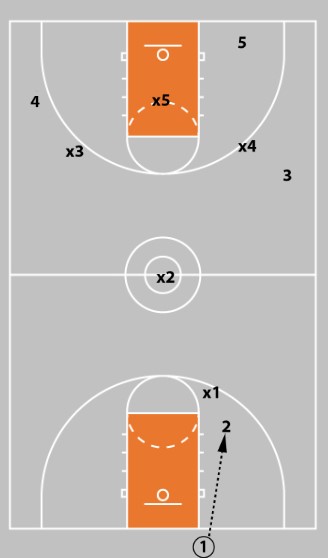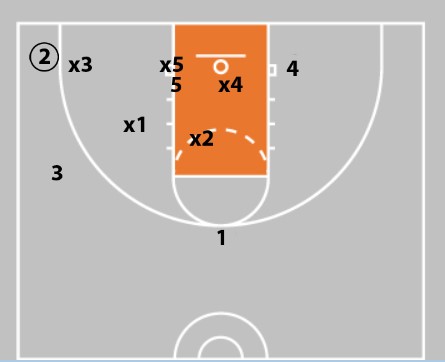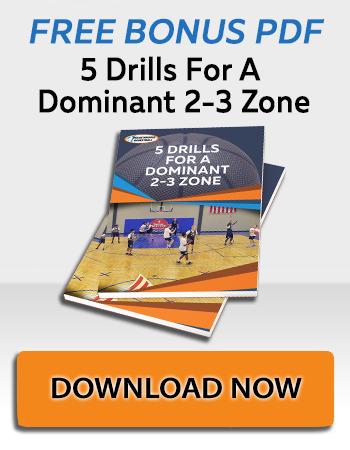5 Ways Al Marshall's Adjusts His 2-3 Zone To Exploit His Opponent's Weaknesses
Coaches are notorious for their "What if's?" Often, these "what if's" cast doubt on a specific strategy.
No matter how far fetched, it's easy for coaches to fall into this. We want to be prepared for anything. As a result, we imagine everything that could go wrong.
One stereotype of the 2-3 zone is that it's played one way, regardless of the personnel of the team playing it or their opponents.
False! In fact, there are a number of tweaks you can make to your 2-3 to tailor it to the needs of your team. Coach Al Marshall's 2-3 Zone Defense used all these and more on his way to over 700 career coaching victories.
Here are a handful from our latest YouTube video - 5 Scout & Personnel Specific Ways To Tweak Your 2-3 Zone.
To get FREE 5 Drills For A Dominant 2-3 Zone, click the banner below
"What If I Have Athletic Guards?"
Some coaches worry athletic guards will be wasted in a 2-3. Not at all!
Option 1 - Move Up The Zone

Simply move the zone up. All 5 players move from their typical starting spots.

X1 & X2 will apply pressure to 1, trying to force a bad pass.
The backline players try to anticipate the next pass and are in position to go for a steal.
Option 2 - Tandem Start

Instead of starting in a traditional 2-3 look, have your guards start in a tandem formation.
X1 comes up to press the ball, leaving X2 to guard the high post.

On a wing entry, X2 takes the first pass
X1 drops to the high post.
What If I Want To Play 2-3 But Also Want To Press?
Many coaches perceive a 2-3 to be a passive defense. That's only the case if you play it that way.
Here are a couple pressing options.
Option 1 - 2-2-1 to 2-3

A 2-2-1 press is a natural complement to a 2-3 zone. Players are in the same formation, just extended full court.
You can play the press as aggressively as you want before falling back into the 2-3.
Option 2 - Tandem Full Court Press

A second option is to apply the same tandem principles we covered above.
Have your best guard defender (x1) apply full court pressure. They will defend whoever catches the inbounds pass and look to force a bad decision.
At the very least, they should be able to get the ball out of the hands of the offense's primary ball handler.

If the ball is advanced, normal tandem rules apply.
The other guard (x2) takes the wing pass.
X1 sprints back and covers the high post.
What If I Am Playing Against A Great Perimeter Player?
Option 1 - 1-3 Chaser

In this case, 4 players are playing normal 2-3 rules. The 5th player is denying the other team's star. In this example, that's x2.
The forwards start a step higher than normal. This gives 1 extra help as they would have the top and would also need to cover the wing after the forward stunts.
The rotations are the same for the 4 zoning players. This means this variation does not take a lot of practice time.
Option 2 - Box The Star
In Coach Marshall's terminology, boxing the star means trapping. In other words, whenever the star player has the ball, you run a 2nd defender at them.
This does a couple things:
- Forces lesser players to beat you
- Creates opportunities for turnovers, especially if the star catches the ball in the
What If I Am Playing Against Good Shooters?
It's unusual to play a team that has 3 outstanding shooters on the perimeter.
You can take advantage of this by playing closer to the great shooters and not devoting as much attention to the poor shooters.
Poor Shooting Wing
If the weaker shooter is on the wing, the guards can shift toward the stronger shooters.

In this scenario, 2 is the weaker shooter.
As a result, x1 & x2 shift to stay closer to 1 & 3.
Poor Shooting Point Guard

If the point guard is a weak shooter, the x1 & x2 will flatten out & widen out. This keeps them closer to the wings.
X5 will step up higher. If there's an offensive player in the high post, x5 will play them 1v1.
X3 & x4 are ready to drop down to the basket area on any high post pass.
Coach Marshall sums it up this way, "with the zone, sometimes you may not be able to stop a team from shooting, but you can pick who shoots."
What If I Am Playing Against A Great Post Player?
In this case, you want to prevent them from getting the ball. This requires other players in the zone to shade towards the post player, making the post pass unavailable.
Ball On Wing

When the ball is on the wing, the opposite guard (x2) and ball side forward (x3) help deter the post pass.
X2 drops down an extra step.
X3 pulls in an extra step.
Ball In Corner

When the ball is in the corner, the guards drop down further.
x5 plays on the bottom side of 5, meaning any post pass would have to be on the top side.
X1 & x2 are in position to make a play on that pass.
A Defense That's Ruggedly Flexible
The phrase "rugged flexibility" has become popular recently. It suggests something that is tough and durable but also can adapt and change without breaking.
That's exactly what a good defense should be.
Players should have clarity on the mission and the absolutes. But they should also have confidence in their ability to make necessary changes when those pesky "what if's" present themselves.
Al Marshall's 2-3 Zone Defense does just that. In doing so, it creates the ultimate "what if" for your opponent - "what if we can't score on this defense!"
To get FREE 5 Drills For A Dominant 2-3 Zone, click the banner below
What do you think? Let us know by leaving your comments, suggestions, and questions...
|
||||||||




 Facebook (145k Followers)
Facebook (145k Followers) YouTube (152k Subscribers)
YouTube (152k Subscribers) Twitter (33k Followers)
Twitter (33k Followers) Q&A Forum
Q&A Forum Podcasts
Podcasts